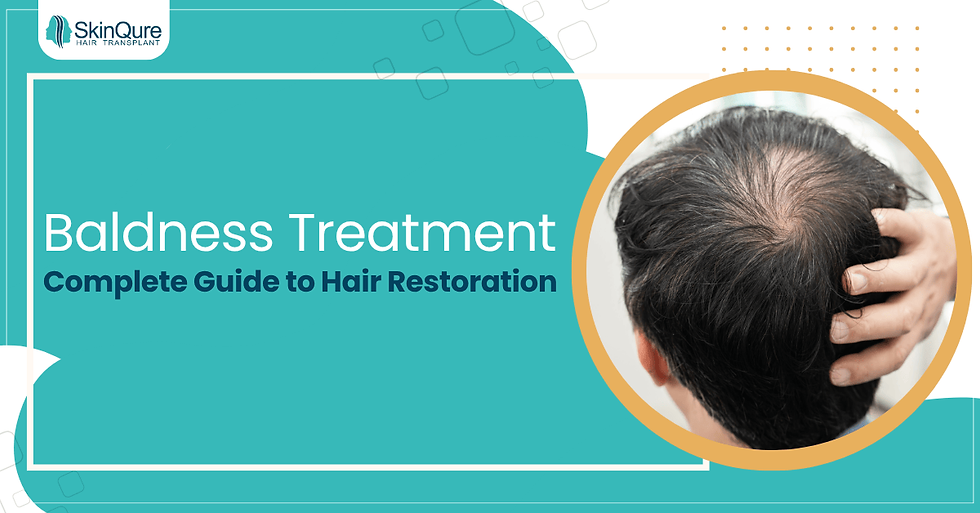2 hours ago
Male Pattern Baldness: Early Signs & Treatment Guide
- Dr Jangid, MD
- Oct 29
- 3 min read

Androgenic alopecia, often known as male pattern baldness, is a form of hair loss that affects men. It results in hair loss and non-regrowth on the scalp, the skin covering your head. A receding hairline, which shifts farther back on your head, and thinning hair are additional indicators of male-pattern baldness. At SkinQure, we have individualized treatment guide under the guidance of Dr. Jangid at SkinQure, so every patient gets specific advice and treatment.
Male pattern baldness is one of the most common types of hair loss among men. The male balding pattern occurs in seven stages. Some individuals have symptoms in their late teens or early 30s.
Signs and symptoms of male pattern baldness
The common symptoms of male pattern baldness are:
Hair loss or thinning of hair in the crown
Hair loss or thinning of hair at your temples
Hairline receding
Male pattern baldness is not painful. This baldness begins as early as your late teens or early twenties, but most individuals notice the first signs in their 30s. Detection of these early signs aids men in seeking experts and initiating preventive treatment. Dr. Jangid emphasizes that even minor baldness cannot be neglected since early treatment can slow down the process and preserve hair thickness.
Different Male Pattern Baldness Treatment Options
At SkinQure, we have a variety of treatments available to cure male pattern baldness. Every package is tailored based on the hair loss stage and patient requirements. Dr. Jangid offers a full consultation, giving you all the options in detail prior to beginning treatment.
Medications
Finasteride and Minoxidil are used to treat male pattern baldness. Finasteride lowers the level of DHT, inhibiting hair follicle contraction. On the other side Minoxidil increases blood supply to the scalp.
Hair Transplant
Advanced cases can be effectively treated by a hair transplant. Expert treatments using methods such as FUE (Follicular Unit Extraction) and FUT (Follicular Unit Transplantation) are offered. Dr. Jangid of SkinQure uses the natural growth direction of transplanting hair so that it looks natural. Care after surgery and follow-ups are also crucial to attain maximum results.
PRP Therapy
Platelet-Rich Plasma (PRP) therapy is another new procedure. It involves the injection of platelet-rich plasma into the scalp to stimulate hair growth. PRP may result in thickening of the hair and hair strengthening when used with medication or hair transplantation surgery. Dr. Jangid offers PRP according to patterns of hair loss and conditions of the scalp.
Lifestyle and Hair Care
Healthy living and proper hair care are accompanied by medical interventions. Proper diet, tension-free living, and proper exercise can check baldness from male pattern. Dietary guidance, supplements, and scalp care practice are offered by Dr. Jangid for long-term improvement.
Consultation at SkinQure
Consultation is the initial step of the treatment guide for male pattern baldness at SkinQure. Complete scalp check-up is done by Dr. Jangid, where hair density is tested, and medical history is maintained on patients' records. He plans treatment based on individualized age, amount of hair loss, and lifestyle. Follow-up is made at regular intervals to assess progress and make appropriate changes.
Conclusion
Male pattern baldness is a prevalent but controllable condition. Early signs and timely intervention prevent extensive hair loss. Knowledge regarding early symptoms of male pattern baldness, etiology, and existing alternative treatment strategies is required. SkinQure, under the observation of Dr. Jangid, renders professional advice, personalized treatment, and current treatments to help men regain their confidence. Timely intervention and appropriate care make all the difference in controlling male pattern baldness.
FAQs
What is the best age to start baldness treatment?
The best age to start baldness treatment is early 30s for effective cure.
Can male pattern baldness be cured?
Yes patterned baldness can be treated with Medication, PRP, or hair transplant can cause hair growth in the majority of patients.
How does Dr Jangid treat male patterned baldness?
He advises, checks scalp, gives medicines, and observes hair growth on a regular basis.
Do lifestyle modifications help manage male pattern baldness?
Yes, good nutrition, reduction of stress, and care of hair retard hair loss is enough.








Comments